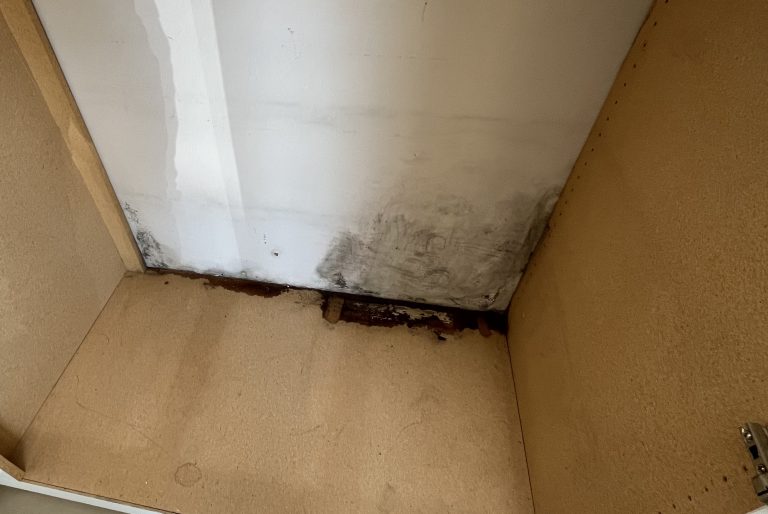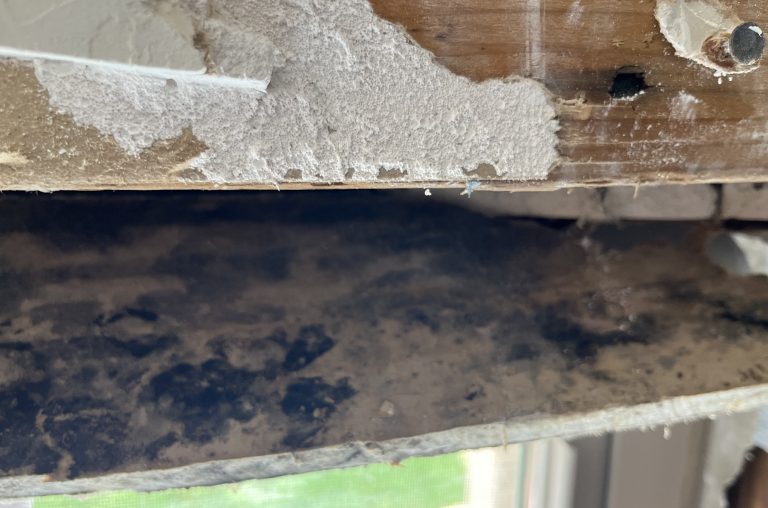
Whether you're looking to buy a new home or been in one for a while, it can be really important to recognize if there is water damage in your walls. Most leaks are obvious and easy to repair while wet. But those buried behind ceilings, pipes, or walls might be difficult to discover and can cause costly damage.
If a water leak wasn't treated properly it may have lead to mold growth, not only do you have to consider the water damage but worry about significant health risks. That's why it's a great idea to become familiar with the frequent indicators of hidden water leaks.
We get it! This should be a no brainer! But we get so many calls where a homeowner is just trying to figure out what they should be doing. We all get that 'deer in the headlights' look when an emergency pops up. Don't worry you're not alone! We do this every day and can help to minimize the damage and get you back on your feet quick!
If it might be a pipe leak, find the main line in to your house (normally outside by a hose bib with a pipe that goes down into the ground) and turn the lever. This will shut off the water to the home. This should stop or at least slow down most pipe leaks.
Your water heater also has a shut off valve on one of the to lines coming from the wall. Be careful the hot water coming out of your heater is likely scalding hot. Best to turn it off and call in a pro. Or click from more info on what to do with a potential roof leak.
Arizona is well known for it's heavy monsoon season each summer. Monsoons are often associated with high winds and sudden microbursts of intense rainfall. These summer storms are punishing on a roof system and pour rainfall past a dislodged a roof tile or leak through window.
When this happen water works its way through your attic, into the insulation and down a wall or into your ceiling. Because of the paint on your wall is very elastic and a great sealant, water can collect into areas and create a giant bubble in your ceiling.
If you notice sagging paint on your wall, it may not seem like a big issue. However, water has had to travel a large distance and covered a lot of area for paint to droop like that. As materials in your wall get wet the paint loses it's hold on the drywall and you get saggy paint.
Most often when roof or window leaks happen, they tend to travel down exterior walls or walls that share a side to the outside. In this case they're also leaking into insulation which is very difficult to dry out on it's own.
In both cases when the wall begins to dry again or is dry, you will notice ripples or flakes in the paint. If someone did not take care of the issue immediately, these are good indicators that there is a much more serious problem lurking behind the drywall.

It's fine to poke a hole in the bubble and drain it into a bucket. This actually releases some of the pressure being put on your ceiling which can otherwise build up and collapse after a short time. You may want to move any valuables underneath a bubble that has formed.
Also be cautious not to sit or sleep under any ceiling that has these types of bubbles forming. If water is leaking through a fan or light, do not turn on the light. It might even be a good idea if you can safely turn of the circuit breaker to that room.
Not all roof leaks or pipe leaks are completely catastrophic. They might start out as a little drips and then turn into bigger problems later down the road. Because rain happens infrequently in Arizona, its normal to get a small leak in your ceiling that then dries out over time.
While there is always a concern for mold, the other concern is that in the next storm those weak areas will lead to a much bigger issue. If you're looking at purchasing a new home, keep your eyes peaked toward the ceiling to see if there are any spots in the ceiling. They will normally be a shade of yellow, with flaking paint or sagging circle.
If you see any discoloration in the ceiling, it is great idea to have a roofer or home inspector, inspect the roof for potential damages.

When materials of your home like drywall or flooring come in contact with large amounts of water, it will start to produce a distinctive musty scent. The longer you wait to address the issue the more that smell persists. This musty smell, along with allergic reactions like sneezing, stuffy nose, and asthma are strong indicators of microbial growth such as mold.
While it can some times be difficult to see mold growth that is happening within the walls of your own home, there are key things you can look out for:
Even though some of these may seem small, they can be indicators of a larger problem existing behind the drywall or a cabinet. Even small amounts of mold can be dangerous to your health.
A common misconception is that mold will die off once a leak has stopped and everything has dried out. Meaning that there is no threat to you once it has died. While the colony may be dead, mold spores can still travel throughout the air in your home.
If you start experiencing respiratory problems, burning eyes, or headaches, you may want to have your home checked by a professional. Air sampling and other tests can help to pinpoint exposure and develop a plan to remediate your home.
Even small drips can cause major damage. We often see a reverse osmosis line (R/O water line) or the water line to the back of the fridge leak. Because of where they are located and that they aren't always the highest pressure these can go on for a long time without being noticed.
You may notice that the wall is cool to the touch and most importantly it has become very soft. Meaning you can put a little bit of pressure on the wall and the drywall is very squishy. You will feel like you could almost poke a hole with your finger.
This type of leak is definitely something you want to get addressed right away. If it has gone on for a long period of time, it could have travelled a very far distance and caused a lot of damage. They are prime candidates for heavy mold growth, especially 'black mold' like Stachybotrys. While mold can make a situation more complex, we can mitigate the issue and protect your family.
A taletell sign of water damage is around baseboard and trim. During a leak, water will travel down underneath flooring and wall systems. The water then absorbs into the materials causing swelling baseboard and trim.
As they expand they will stretch the paint and caulking away from the wall. This is a good indicator that there is a significant water damage issue.
Unfortunately some homeowner decide not to take care of water leaks when they happen. In cases like the above, when the materials dry out on their own the baseboard will shrink back down to it's normal size.
However the paint and caulking have now delaminated. You will see the paint balloon or have cracking/flaking paint along the seam of the baseboard and the wall. It's important to note that this can indicate that it was not properly remediated and can have a bigger issue inside the wall.
Laminate and luxury vinyl plank (LVP) have come a long way in style and appearance in the last several years. They are an inexpensive to tile or hardwood and come in various styles and price points.
It may not be the biggest offender when it comes to long term water damage, it is important to know what to look for when you have a leak in your home or if you're considering buying a new home.
Both laminate and LVP are generally made of wood and when they get significantly wet the edges of each plank will start to rise. This is called crowning. Mold and mildew can grow underneath the flooring system and trap moisture.
When a leak initially happens it may not seem like the flooring has been affected. However, you may start to see crowning appear 24-48 hours after a water leak. What is worse is that it can take several days before it starts to smell from the microbial growth, which can become over powering and very uncomfortable to live with.
Some products are considered to be water proof because they are made completely of plastic and rubber. While it's true the flooring product might not be damaged by repeated water exposure, it can still trap the water underneath and cause potent smells and potentially damage to your subfloor.
But how do you detect water damage in walls if there are no signs you can see? Well, sometimes, it may take a while before you notice any sign.
One indicator can be an increase in usage to your monthly water bills. In cases of a slab leak (where a pipe may have broken underneath your foundation), there may not be an outward signs at all. Even some pipe leaks within the home can go on for a very long time without it being obvious that there is an issue. Either way, paying attention to large usage increases on your water bill can help to identify a problem.
Similarly, if you suspect that a water leak is occurring but aren't sure. One option is to make sure no valves are open in your home and then look at your outside water meter. If it continues to spin then you likely have an active leak somewhere in your home.
Even though there may not be physical signs that you can see on your own, we work with leak detection services to help locate the leak and then develop a plan to repair it.
Have you noticed any of the above signs of water damage in walls? If so, you must act fast. A water damage restoration company can help you fix the problem before it becomes extensive.
At Quick Stop Restoration, we are a trusted water damage restoration service in Mesa, Arizona. If your home has flood damage, plumbing leaks, or water damage on the walls, worry not. We have the tools and expertise to make the necessary restoration.